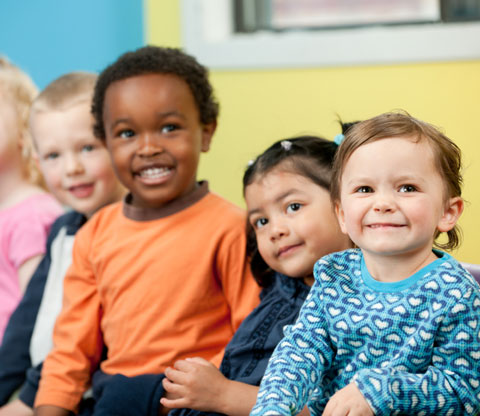Teachers and parents of young children are likely to encounter different checklists or guidelines to assess the development, knowledge, or skills of the young children in their care. Frequent questions asked are: “Who developed these developmental milestones?” “Are learning standards like milestones?” “How can I use these to see if my child is developing normally and gaining skills important for starting preschool or kindergarten?”
Milestones are markers of a child’s development and are available for different ages, such as 6 months, 12 months, 24 months, and through age 5. They are skills that most children learn by a certain age, such as smiling, crawling, walking, pointing to a favorite toy, and using words to communicate. Because each child is unique, a child may develop the new skills at slightly different points in time. Each milestone has a range of normal development. For example, toddlers typically learn to walk around their first birthday, but some may walk as early as 10 months or as late as 18 months, depending on many factors.
The milestones help families, caregivers and health providers recognize whether a child is developing in a typical way. Milestones represent a consensus of child development specialists and health care providers about typical child development. You can find lists of milestones in many books and magazines on child development. It can be fun and rewarding to watch your child reach milestones and to even keep a record of major milestones (said “Mama” first time). If you are worried that a child is not reaching milestones, then be sure to discuss your concerns with families, teachers, and health professionals. Children can be screened at any age for signs of developmental delays. Children who have developmental delays can receive early intervention services to help optimize their development.
Individual states also have developed specific guidelines and standards to support the development of infants and toddlers (children from birth to age 3) and preschoolers (children ages 3–5). These are more specific than developmental milestones; they also are developed by professionals in child development and early childhood education. They guide expectations for what a child should be learning and doing during the first five years. They provide support to caregivers and teachers in planning activities and experiences for young children that support the development across all domains, including social-emotional development, cognition, language, physical development, and health, math, science, art, and social studies. These guidelines and standards support caregivers and teachers by providing a shared set of beliefs of what young children should know and be able to do. They provide common expectations for families and providers.
Standards and guidelines are not goals; rather they represent expectations for age-appropriate play and learning opportunities. For example, a social-emotional standard for preschoolers is “develop self-management skills to achieve school and life success and develop positive relationships with others.” This is a broad expectation, and it can be addressed throughout the preschool years by considering benchmarks of the standard. Benchmarks for this standard include identifying and managing one’s emotions and behaviors by (a) recognizing and labeling basic emotions; (b) using communication skills to express needs, wants, and feelings; and (c) beginning to understand and follow rules.
Children experience many activities and opportunities that relate to this standard just through day-to-day experiences at home and preschool. Think of a child playing in the house corner of a preschool, assuming the role of mommy, feeding a baby doll, and asking a friend to bring her baby doll over. They may be recognizing or “playing” baby emotions (e.g., crying) and responding with caregiver’s emotions (soothing the baby, feeding the baby). The children may talk about why the baby is crying and what they need to do. They also may recognize that playing house means staying in the house corner (following rules).
Developmental milestones, early learning guidelines, and early learning standards provide guidance for adults who care for children. They are not meant to be “taught” directly. Rather, they serve as markers for what our culture considers to be typical development. They also serve as guides for experiences that children should have in their daily lives that will prepare them to be successful in later life. The IEL website has a complete list of the Illinois Early Learning Guidelines for children birth to age 3 and the Illinois Early Learning and Development Standards (IELDS) for children age 3 to kindergarten enrollment. Each contains many resources to guide caregivers and teachers in providing enriching opportunities for their young children. They also provide information for adapting interactions, experiences, and activities to support the needs of young children whose development may be delayed.

Susan Fowler
Dr. Susan Fowler is a retired professor of special education at the University of Illinois. Susan’s doctorate was in developmental and child psychology and she was one of the pioneers in early childhood special education and developmental disabilities. She also is a parent of a young man with exceptionalities.
Biography current as of 2022


